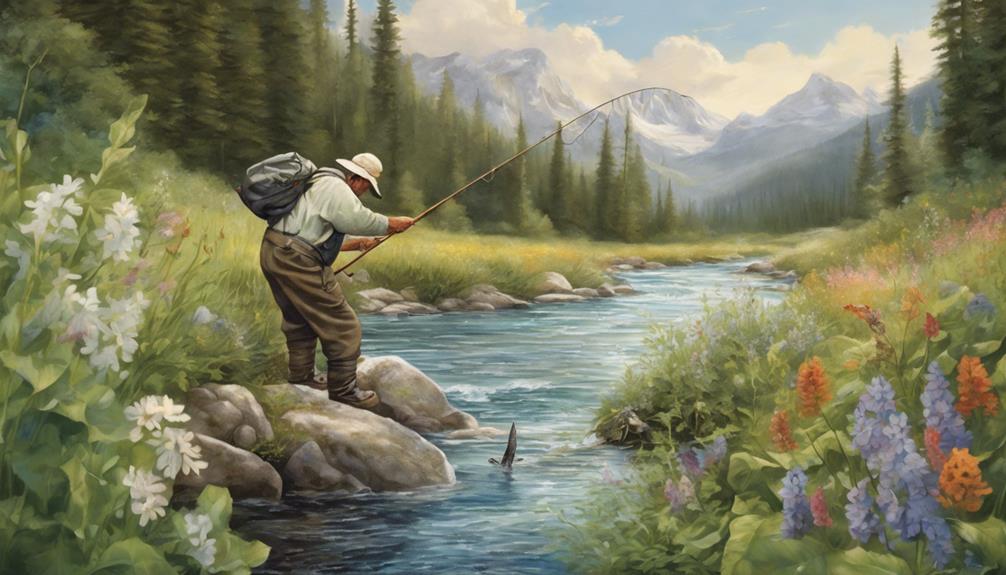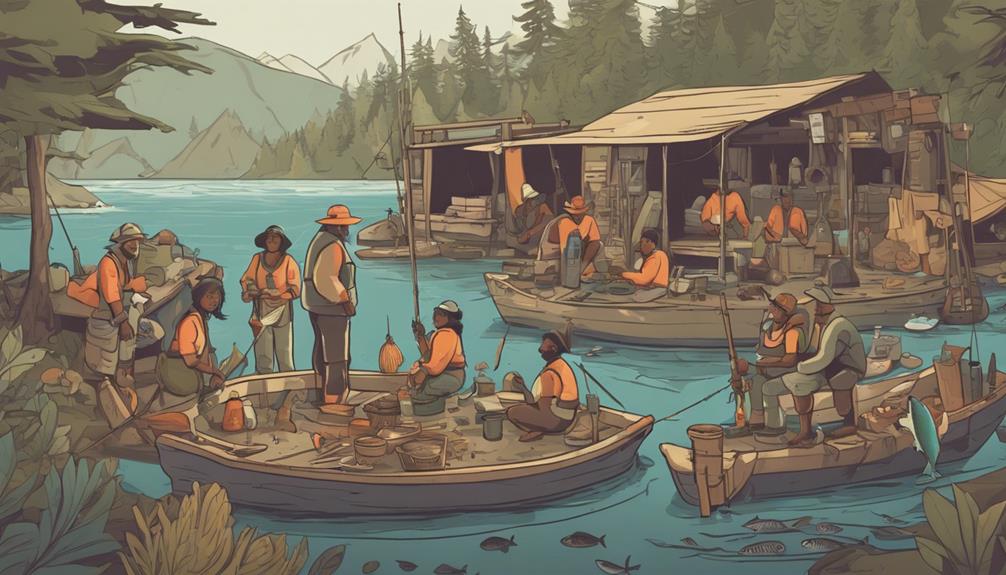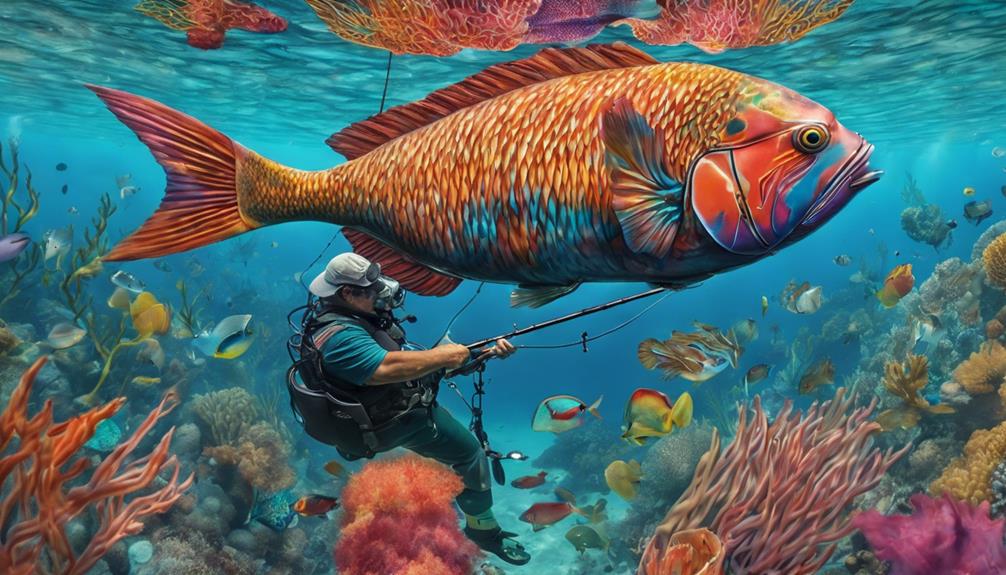Have you ever wondered why catch and release is considered crucial in species-specific fishing?
It's not just about the thrill of the catch; there's a deeper purpose behind this practice that goes beyond the surface. By releasing certain species back into their natural habitats, anglers play a significant role in the conservation of fish populations and the preservation of genetic diversity.
But there's more to it than meets the eye – continue to explore the multifaceted benefits that catch and release brings to the world of angling.
Importance of Species-Specific Fishing
When fishing, it's crucial to target specific species to maintain ecological balance and preserve biodiversity. Selective harvesting is a practice that focuses on catching only certain species while releasing others back into the water. By targeting specific species, you're helping to ensure that populations remain stable and that the ecosystem stays in balance.
Ecological balance is essential for the health of aquatic environments. Each species plays a unique role in the ecosystem, and when one species is overfished, it can have ripple effects throughout the food chain. By practicing selective harvesting, you're contributing to the overall health and sustainability of the ecosystem. For example, if a predator species is overfished, it can lead to an increase in prey species, which can then have detrimental effects on other parts of the ecosystem.
When you engage in species-specific fishing, you're actively participating in the conservation of marine life. By releasing non-targeted species back into the water, you're helping to maintain biodiversity and protect vulnerable populations. This approach not only benefits the environment but also ensures that future generations can continue to enjoy the beauty and diversity of our oceans. Remember, your actions as a responsible angler can make a significant impact on the delicate balance of marine ecosystems.
Benefits of Catch and Release
To maximize the sustainability of fishing practices, embracing catch and release offers numerous benefits for both fish populations and ecosystems. When you release a fish back into the water, you contribute to the overall health of marine life and ensure that future generations can continue to enjoy fishing.
- Fish survival: By releasing fish back into their natural habitat, you give them a chance to survive and reproduce, helping to maintain healthy population levels.
- Angler satisfaction: Catch and release fishing allows you to experience the thrill of the catch without negatively impacting fish populations. It promotes a sense of responsibility and stewardship among anglers.
- Ecosystem balance: Returning fish to their environment plays a vital role in preserving the delicate balance of ecosystems. It helps maintain biodiversity and supports the food chain.
- Regulatory compliance: Catch and release practices often align with fishing regulations and conservation efforts, ensuring that you're fishing responsibly and in accordance with guidelines set to protect marine life.
Conservation of Fish Populations
Preserving fish populations is essential for the sustainability of marine ecosystems and the future of recreational fishing. Effective population management and conservation strategies are crucial to maintain healthy fish stocks and ensure the balance of the ecosystem. Overfishing and habitat destruction have significant ecological impacts, leading to the decline of fish populations and disrupting the natural food chain.
Conservation efforts focus on implementing measures such as catch and release practices, size and bag limits, and marine protected areas to safeguard fish populations. These strategies help in regulating fishing pressure, allowing fish stocks to replenish and maintain a stable population size. By controlling the number of fish caught and ensuring the survival of breeding adults, conservationists aim to prevent species from being overexploited and facing extinction.
Maintaining a diverse and abundant fish population is vital for the overall health of marine ecosystems. Fish play a crucial role in maintaining the balance of aquatic environments, influencing the abundance of other species and the overall ecosystem dynamics. Therefore, by preserving fish populations through conservation efforts, we contribute to the protection of not only individual species but also the intricate web of life within the oceans. Prioritizing the conservation of fish populations is key to ensuring sustainable fishing practices and the long-term health of marine ecosystems.
Enhancing Genetic Diversity
Maintaining healthy fish populations not only contributes to the overall health of marine ecosystems but also plays a crucial role in enhancing genetic diversity within fish species. By practicing catch and release fishing, you actively participate in improving survival rates and maintaining healthy populations. Here's how enhancing genetic diversity through catch and release benefits fish species:
- Increased Adaptability: By releasing fish back into their natural habitat, you allow them to pass on their diverse genetic traits to future generations, enhancing their ability to adapt to changing environmental conditions.
- Reduced Inbreeding: Releasing fish helps prevent inbreeding within populations, which can lead to various genetic abnormalities and decreased overall fitness. Maintaining genetic diversity is crucial for the long-term survival of fish species.
- Resilience to Diseases: A genetically diverse population is better equipped to combat diseases and parasites. By releasing fish and promoting genetic diversity, you contribute to the overall health of fish populations.
- Sustainable Fisheries: Enhancing genetic diversity through catch and release practices ensures the sustainability of fish populations for recreational and commercial fishing, preserving these resources for future generations. Your role in enhancing genetic diversity through catch and release fishing is vital for the long-term health and sustainability of marine ecosystems.
Sustainable Angling Practices
By practicing sustainable angling practices, you can play a crucial role in conserving fish populations and their habitats. Ethical harvesting and adherence to regulations are fundamental aspects of sustainable angling practices. When you engage in fishing, it's essential to consider the impact of your actions on the environment. Following regulations regarding catch limits and sizes helps maintain healthy fish populations and ensures that fish stocks aren't depleted beyond sustainable levels.
Sustainable management is key to preserving the delicate balance of the ecosystem. By practicing catch and release where appropriate, you contribute to maintaining the biodiversity of fish species. Releasing fish back into their natural habitat allows them to reproduce and contribute to the overall health of the population. Additionally, practicing selective harvesting by targeting invasive species or those with abundant populations can help protect more vulnerable species from overexploitation.
Preserving Rare Species
If you occasionally encounter a rare species while fishing, consider releasing it back into the water to support its conservation. Rare species protection is crucial for biodiversity preservation and maintaining ecological balance. Here are some reasons why preserving rare species through catch and release is essential:
- Maintaining Genetic Diversity: Rare species often have unique genetic traits that are important for the overall health of the population. By releasing rare individuals, you help preserve these valuable genetic variations.
- Preventing Population Decline: Rare species are particularly vulnerable to population declines due to factors like habitat loss and overfishing. Releasing them back into their natural environment can help prevent further declines and support population recovery.
- Promoting Species Resilience: Rare species may struggle to adapt to environmental changes, making them more susceptible to extinction. By releasing them, you give these species a better chance to adapt and thrive in their natural habitat.
- Supporting Ecosystem Health: Every species plays a unique role in the ecosystem. Preserving rare species helps maintain the delicate balance of interactions within their habitats, contributing to overall ecosystem health and stability.
Minimizing Environmental Impact

To reduce the environmental impact of fishing, it's important to practice sustainable techniques that prioritize the well-being of aquatic ecosystems. One key aspect of minimizing this impact is through reducing mortality rates of non-targeted species. Catch and release fishing plays a crucial role in this by allowing fish to be safely returned to their habitats, increasing their chances of survival. When done correctly, catch and release methods can significantly lower the number of unintended fish deaths, helping to maintain the balance of marine life.
Another vital factor in minimizing environmental impact is protecting habitats. By avoiding destructive fishing practices, such as bottom trawling or using illegal gear that can damage coral reefs and other sensitive ecosystems, anglers can help preserve the natural habitats of marine species. These habitats serve as breeding grounds and shelters for many fish species, and their protection is essential for maintaining biodiversity in the oceans.
Incorporating these practices into your fishing routine not only contributes to the conservation of marine life but also ensures that future generations can continue to enjoy the beauty of our oceans. By being mindful of reducing mortality rates and protecting habitats, anglers can play a significant role in promoting sustainable fishing practices and safeguarding the health of aquatic ecosystems.
Promoting Ethical Angling
Promote ethical angling by adhering to proper fishing regulations and guidelines, ensuring the well-being of aquatic ecosystems and the sustainability of marine life.
Engage in angler education to learn about ethical practices and responsible angling techniques.
Contribute to wildlife conservation efforts by practicing catch and release, especially with endangered species.
Respect fishing regulations regarding catch limits, sizes, and protected areas to maintain a balanced ecosystem.
Support sustainable fishing practices by using non-invasive fishing gear and techniques to minimize harm to marine life.
Frequently Asked Questions
How Can Catch and Release Fishing Techniques Be Adapted for Different Species of Fish?
When you're fishing for different species, it's essential to adapt catch and release techniques accordingly. Consider species-specific behaviors and needs. Use appropriate gear and handling methods to minimize stress on the fish.
Always prioritize their welfare by quickly releasing them back into the water. By understanding and applying adaptation techniques tailored to each species, you can ensure successful catch and release practices.
What Are the Potential Negative Impacts of Not Practicing Catch and Release Fishing on Specific Fish Populations?
Not practicing catch and release fishing can have negative consequences on specific fish populations. It can lead to overfishing and a decline in certain species.
Conservation efforts are crucial to maintain healthy fish populations. By practicing catch and release, you can help preserve fish stocks and ensure sustainable fishing practices.
It's important to consider the impact of your fishing activities on the environment and take steps to protect vulnerable species.
Are There Any Specific Regulations or Guidelines in Place to Ensure the Success of Catch and Release Fishing for Different Species?
Regulatory compliance is key in species-specific catch and release fishing. Conservation efforts rely on adherence to guidelines that ensure sustainability measures are met. These regulations protect fish populations and promote species protection.
How Does Catch and Release Fishing Contribute to the Overall Health and Sustainability of Fish Populations in a Specific Ecosystem?
Catch and release fishing benefits the overall health and sustainability of fish populations in a specific ecosystem by allowing fish to reproduce and maintain healthy population levels.
Through conservation efforts like catch and release, you play a vital role in preserving fish populations for future generations.
What Are Some Common Misconceptions About Catch and Release Fishing and How Can They Be Addressed to Promote Better Understanding and Adoption of the Practice?
When it comes to catch and release fishing, there are some common misconceptions out there. People mightn't realize the misunderstood benefits and the need for education on this practice.
To promote better understanding and adoption, it's crucial to address these misconceptions. By highlighting the positive impact on conservation efforts and the environment, we can encourage more people to embrace catch and release fishing responsibly.
Conclusion
In conclusion, catch and release is crucial in species-specific fishing because it helps conserve fish populations.
It enhances genetic diversity, promotes sustainable angling practices, preserves rare species, minimizes environmental impact, and promotes ethical angling.
By practicing catch and release, you can play a vital role in ensuring the long-term health and sustainability of our aquatic ecosystems.
So next time you're out on the water, remember the importance of releasing your catch to help protect our precious fish species.



